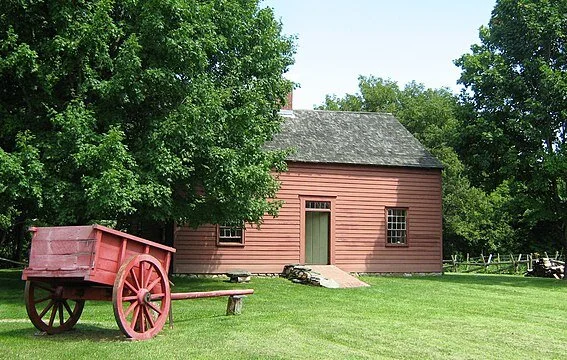
Suresh Garimella: UVM's role in helping Vermont recover from COVID crisis
Named for U.S. Sen. Justin Smith Morrill, Morrill Hall at the University of Vermont was built in 1906-07 as the home of the UVM Agriculture Department and Agricultural Experiment Station.
Via The New England Journal of Higher Education, a service of The New England Board of Higher Education (nebhe.org)
BURL.INGTON, Vt.
Gracing the back wall of my office at the University of Vermont is an antique wooden desk that’s more than 150 years old. While it’s an undeniably handsome piece of 19th Century craftmanship, it serves much more than a decorative purpose.
As the desk of Vermont Sen. Justin Smith Morrill, the author of the Morrill Act of 1862, which established the country’s first land-grant universities, it is my lodestar, a vivid reminder of UVM’s status as one of the nation’s earliest land grants and of the solemn responsibilities that come with that designation.
Count me as a true believer in the land-grant mission and among its greatest fans. The first land grants, so called because the U.S. government donated federal land to each state to establish a university, were a brand new idea: higher education for everyday people focused on the practical subjects of agriculture and the mechanical arts, whose purpose was to improve the economic and cultural well being of the people in their state.
Why am I so passionate about UVM’s land-grant mission? Because Vermont, as much as any state in the nation, faces a series of daunting challenges—from population decline to stagnant economic growth—that a land-grant university like UVM is powerfully equipped to address.
In the middle of a pandemic that has rendered these challenges even more acute, there is another reason to believe in the land-grant mission. Land grants like UVM have a key role to play in helping their states recover economically from the ravages of COVID-19.
The economic impacts of the pandemic are indeed unprecedented. In the second quarter of 2020, the national economy shrank at an annualized rate of nearly one-third. Millions of jobs were lost in New England. And in Vermont, despite the state’s lowest-in-the-nation infection rate, unemployment in July was 8.3 percent, and the state has the highest budget deficit in its history.
How can land-grant universities help spur economic recovery in their states? In Vermont, we’re looking at bringing the power of the university to bear on these challenges in a number of ways.
We’ll take full advantage of one of UVM’s most important resources: our bright and capable students. In a post-COVID economy, employers—from tech firms to media companies to nonprofits—will be in dire need of eager-to-learn, dependable, qualified employees. To meet this need, we’ll significantly enhance our internship programs, so more students, beginning in their first year, can be exposed to career options in the state by interning with a Vermont employer. Just as important, we plan an active outreach and education campaign to employers, so they know how to connect with and engage our talented students.
We’ll harness the strength of another great university resource: the talents of our faculty, who last year brought over $180 million in research funding to the university. In the coming months, with support from our faculty, we will help businesses around the state apply for federal Small Business Innovation Research (SBIR) and Small Business Technology Transfer (STTR) grants, proven ways to help businesses grow.
We plan a concerted and sustained effort to attract our out-of-state alumni, a high percentage of whom are entrepreneurs, back to Vermont, a state they love, providing them with technical assistance so they can relocate their companies, envision new ways of working from home or start new businesses here.
We’ll mobilize the intellectual firepower of our faculty to help policymakers craft local and state programs that address socioeconomic challenges the state is facing, which hold back wellbeing and prosperity. In a survey of food insecurity in the state, for instance, faculty learned that some Vermont residents were stockpiling food and depriving those in need—a problem that informed policy can alleviate.
We’ll deploy the pedagogical and human development expertise of faculty in our College of Education and Social Services to help Vermont’s K-12 teachers better engage primary school students as they emerge from a remote learning environment and better understand how distance learning, enhanced internship and place-based learning opportunities can help keep college-bound high school students on track.
For many of these efforts, we’ll coordinate with UVM Extension. In an expansion of their traditional role, Extension faculty and staff will act as our on-the-ground implementation agents for community economic development.
As important as these programs are in spurring economic recovery, their impact would be muted without another initiative just funded by the state: UVM’s new Office of Engagement.
The office will function as the front door to the university, with staff who field inquiries from businesses and residents across the state, connecting them with appropriate resources and expertise at UVM.
While the university has a critical role to play in Vermont’s post-COVID recovery, its role in promoting the state’s well being stretches far beyond the current crisis.
Boosting the health, quality of life and prosperity of Vermont and Vermonters is one of the three core imperatives in the university’s recently released strategic vision, Amplifying Our Impact.
The strategic vision continues UVM’s long tradition of engagement with the state. During my tenure, we will become even more deeply engaged with issues of concern throughout Vermont.
The historic wooden desk I keep close by will continue to inspire me. With the help of this daily reminder, I will ensure that UVM’s land-grant mission—to help the state confront both our current challenges and those to come, shaping a bright future for all Vermonters—remains a top priority for Vermont’s university.
Suresh Garimella is president of the University of Vermont.
UVM seal
Good time to be an escape artist
“Boom4Real: Escape Artist Series, {After}Jean Michel Basquiat,’’ by Li Sumpter, at Burlington (Vt.) City Arts but only open for viewing on the Web.
Lake Champlain from the Burlington docks, with the Adirondacks.
— Photo by Jscarreiro
Ethan Allen Homestead (1784)
Old Mill building at the University of Vermont
Jon Reidel: Advice for stressed-out new college students
Williams Hall, at the University of Vermont, in Burlington.
Jaydeen Santos helping a UVM student,
From The New England Journal of Higher Education, a service of the New England Board of Higher Education (nebhe.org).
The students who walk into the office of Jaydeen Santos at the University of Vermont are burdened by a familiar litany of troubles.
They feel isolated. Homesick. Overwhelmed by classes. Unsure where to turn.
Santos, the student services adviser at UVM’s Mosaic Center for Students of Color, knows just how they feel. Because 17 years ago, she was right there with them, among the first students in a groundbreaking partnership with Christopher Columbus High School in the Bronx that had been launched by CFES Brilliant Pathways to help underserved students get into college and diversify UVM’s predominantly white campus. But now she’s in a position to help them avoid the same pitfalls she stumbled into.
When Santos arrived at UVM, she found few mechanisms set up for students of color. The food was unfamiliar, and so were the faces; for the first time in her life, Santos found herself the only person of color most places that she went. She planned on transferring for most of her first semester. “I definitely had a ‘did I make a bad decision?’ moment,” Santos says. “And I hadn’t even started at that point.”But after moving from an almost entirely white dorm to one that housed the ALANA Student Center and more students of color, getting involved in some campus activities, and meeting individuals who were able to help her overcome some of the challenges she faced, she decided to stay—indeed, after getting a job at UVM after graduation, she never left. “I fell in love with the people here,” says Santos.
Here are some of the tips Santos offers first-year students who seek her advice:
Get up and get going! “You need to meet friends, you need to get out of your room, and you need to go to some campus events,” Santos says. She has a hard time remembering which activities she got involved in; the point is simply to get out. At the very least, she says, the student who gets out will feel less alone. More likely, they’ll find something they’re passionate about, meet other people who feel the same way, and soon won’t have time to feel homesick.
You don’t have to go it alone. When Santos was a first-year student, college classes were new and a struggle. “I got Fs,” she recalls. “I didn’t understand how to figure it all out, and I didn’t understand how to ask for help if it got overwhelming.” Often, the advice she gives new students seems basic. But for first-generation students who don’t have any experience navigating academia, the notion of asking for an extension on a paper or the point of attending office hours can be foreign. The worst thing possible, she says, is to quit going to class and hide from professors— as she did.
More than anything, she says, students should realize: Colleges and universities such as UVM want students to thrive, and have established resources to help students deal with all kinds of challenges—academic, social and financial. Don’t have enough money for books? Feel awkward writing an email to a faculty member? Santos, and others in her position, can help students solve the problem. “A lot of students feel like they’re bothering us, asking for help,” Santos says. “This is my job—my job is to be here for students who need me.”
When Santos started at UVM, many of the mechanisms to help students navigate college didn’t exist. In fact, when she arrived, there were so few students of color (just 4 percent of all UVM undergrads) that she felt like she knew every single one.
That’s changed, and the partnership with the high school in the Bronx is one reason why. When it launched, UVM wanted to diversify its student population, and the principal of the high school was eager to give students opportunities they couldn’t necessarily find in the Bronx. CFES President Rick Dalton says the resulting partnership has now brought more than 400 students to UVM. (Today, UVM reports 11 percent of undergraduates are students of color, as well as 10 percent of graduate students and 32 percent of medical students.)
This fall, CFES recognized three of the people who made that Bronx partnership possible: former Columbus Principal Gerald Garfin, former UVM Admissions Dean Don Honeman and former UVM Vice President Thomas Gustafson. UVM President Thomas Sullivan credited the relationship with turning the campus into a more diverse, welcoming community. “Our partnership has developed a path that leads to student success,” he told a group of more than 300 educators, students, industry leaders and others attending the CFES annual conference.
Jon Reidel is director of advancement at CFES Brilliant Pathways.
View from Burlington across Lake Champlain toward the Adirondacks.










